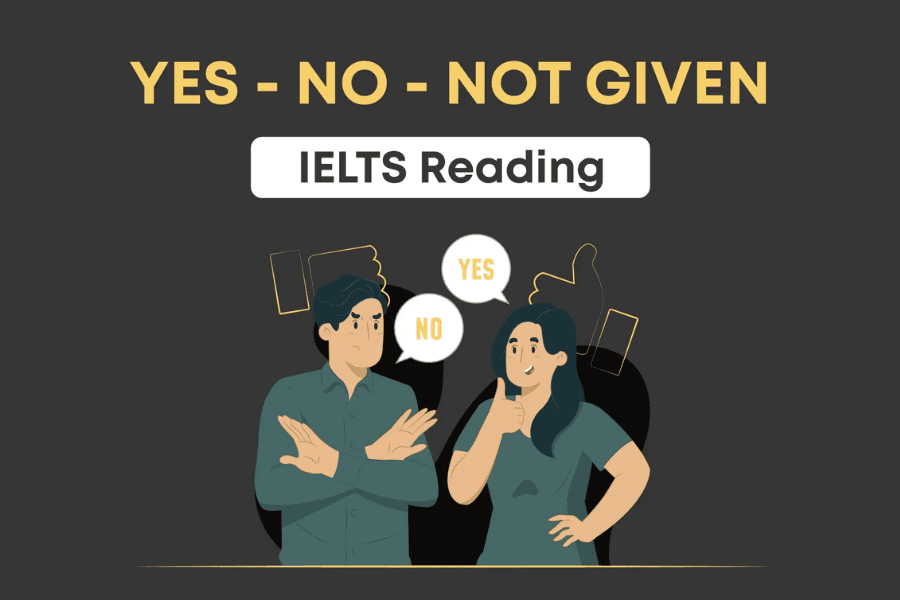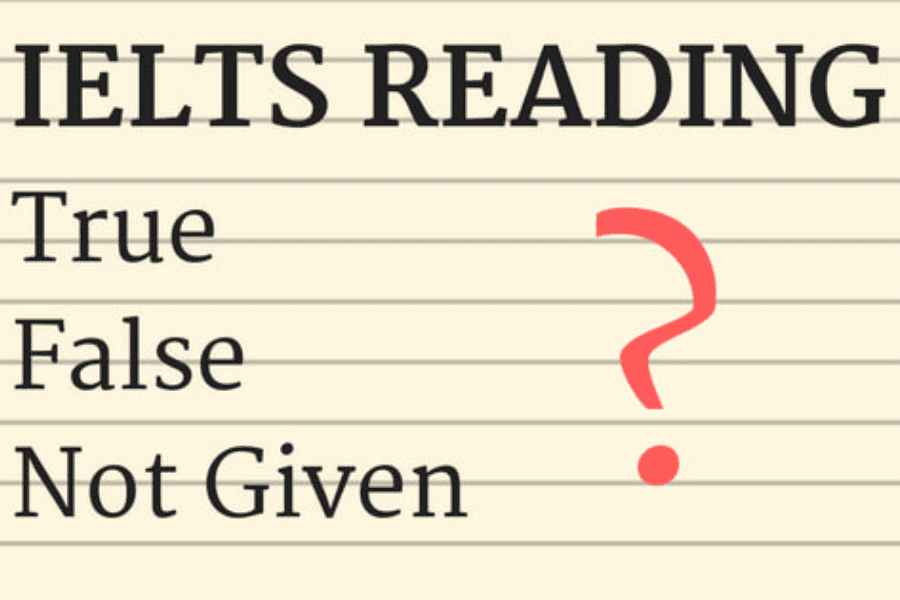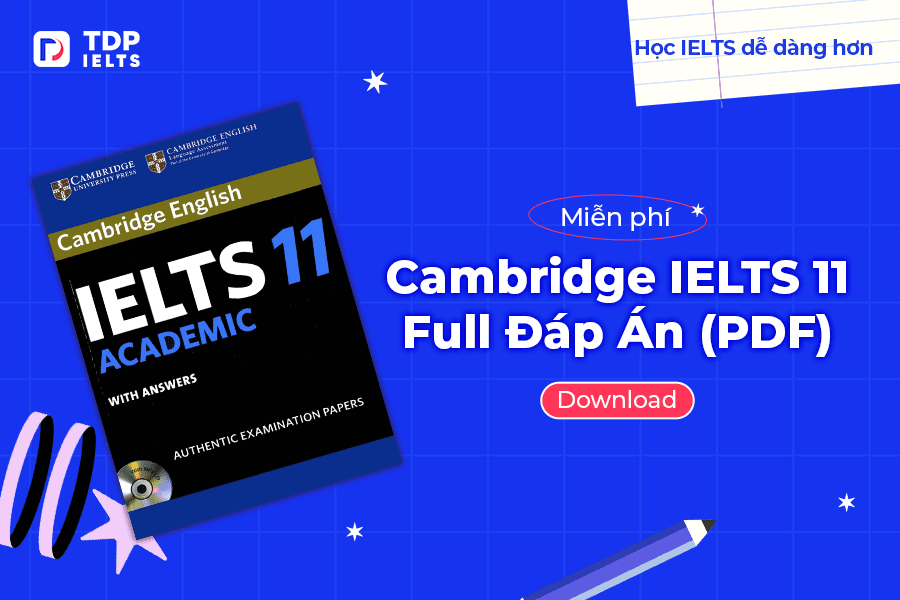IELTS Reading True False Not Given là dạng bài gài “bẫy” nhiều nhất khiến thí sinh bị mất điểm oan. TDP IELTS sẽ gợi ý bạn cách ôn tập và giải mã bẫy hiệu quả tại bài viết!
Tìm hiểu thêm: Lộ trình học IELTS từ 0 đến 6.5+ cho người mới bắt đầu chi tiết nhất
Nội dung
ToggleIELTS Reading True False Not Given là gì?
Dạng bài này yêu cầu ta phải xác định các mệnh đề được đưa ra là True-Đúng, False-Sai hay Not Given-Chưa được đưa ra hoặc không có trong bài đọc.
Trong IELTS Reading, dạng đề này có thể ở 2 hình thức:
- True/False/Not Given
- Yes/No/Not Given
Người làm bài cần xác định mệnh đề mà bài đọc đưa ra là đúng hoặc sai, thậm chí phải xác định xem thông tin đó đã được đưa ra hay chưa, điều đó làm tăng phần khó khăn cho phần IELTS Reading của thí sinh.
So sánh dạng T/F/NG và Y/N/NG trong Reading IELTS True False Not Given
Cùng tìm hiểu về sự khác nhau giữa False và Not Given (difference between True False Not Given and Yes/No/Not given) ngay bên dưới.
- Identifying Information (True / False / Not Given):
Bạn cần đọc và quyết định xem thông tin trong câu hỏi là True (đúng) hay False (sai) hay Not Given (không được đề cập)
- Identifying Writer’s Views/Claims (Yes / No / Not Given):
Bạn cần đọc và quyết định xem nêu trong câu hỏi là Yes (có) hay No (không) hay Not Given (không được đề cập)
Như vậy, ở dạng T/F/NG, bạn chỉ cần nắm được thông tin tác giả nhắc đến trong bài, còn dạng Y/N/NG yêu cầu bạn phải hiểu ý kiến/quan điểm của tác giả.

True False Not Given tips – Chiến thuật làm bài – Cách làm IELTS Reading True False Not Given
Để có thể làm dạng bài True False Not Given in Reading IELTS thật tốt, bạn có thể tham khảo cách sau:
Bước 1: Đọc hai câu hỏi đầu tiên (để ý kỹ đề yêu cầu True/False hay Yes/No)
Bước 2: Xác định từ khóa Keywords
Bước 3: Dùng các từ khóa để xác định vị trí thông tin trong bài (scanning)
Bước 4: Đọc kỹ quanh các từ khóa đã xác định để hiểu rõ nội dung bài, so sánh và đưa ra câu trả lời.
- Yes/True: thông tin trong câu hỏi khớp hoàn toàn với thông tin trong bài đọc (câu hỏi paraphrase nội dung bài).
- No/False: thông tin trong câu hỏi sai hoàn toàn với thông tin trong bài đọc (câu hỏi thường chứa từ trái nghĩa với nội dung tìm thấy trong bài).
- Not given: không đủ dữ liệu để xác định nội dung này đúng hay sai.
Bước 5: Đọc hai câu hỏi tiếp theo. Lặp lại các bước 2,3,4
IELTS Reading True False Not Given Tips:
- Các câu hỏi được sắp xếp theo thứ tự xuất hiện của thông tin trong bài đọc.
- Đừng dành quá nhiều thời gian cho bất kỳ câu hỏi nào. Nếu bạn tìm thấy đáp án của câu 1 và 3, nhưng không thể tìm đủ dẫn chứng cho câu 2, đáp án của câu 2 là Not Given.
- Thông thường mỗi đáp án True/False/Not Given hay Yes/No/Not Given đều sẽ xuất hiện ít nhất một lần.
- Nhiều bạn thường không phân biệt được No/False với Not given.
-
- No/False: dựa vào bài đọc, ta có thể sửa lại câu đó cho đúng.
- Not given: dù có tìm thấy nhiều từ khóa liên quan nhưng vẫn không đủ thông tin để xác định câu hỏi này True/Yes hay False/No (không có từ đồng nghĩa hay trái nghĩa nào cả)
- Các từ rất nhỏ như “always, all, most, more, less, completely…” có thể quyết định một câu là F/N hay NG. Cần để ý kỹ các từ này khi đọc câu hỏi.
Bài tập True False Not Given IELTS Practice mẫu
| Living with Mies
Lafayette Park is a group of modernist townhouses in the US designed by the architect Mies van der Rohe. A few blocks east of downtown Detroit sits Lafayette Park, an enclave of single- and two-storey modernist townhouses set amid a forest of locust trees. Like hundreds of developments nationwide, they were the result of postwar urban renewal; unlike almost all of them, it had a trio of world-class designers behind it: Ludwig Hilbersheimer as urban planner; Alfred Caldwell as landscape designer; and Mies van der Rohe as architect. The townhouses were built between 1958 and 1962 on land previously occupied by a working-class neighbourhood. While much of Detroit began a steep decline soon after, Lafayette Park stayed afloat, its residents bucking the trend of suburban flight. Lafayette Park today is one of the most racially integrated neighbourhoods in the city. It is economically stable, despite the fact that Detroit has suffered enormous population loss. We wanted to know what residents think about this unique modernist environment created by a famous architect, and how they confront and adapt it to meet their needs. During our research, we were struck by the casual attitude that many residents have toward the architecture. Then again, Detroit has an abundance of beautiful housing options: one can live in a huge Victorian mansion, a beautiful arts and crafts house or a cavernous loft-conversion space in a former factory. Living in a townhouse built by a renowned architect isn’t as noteworthy as one might think. At the same time, such nonchalance is a mark of success: the homes are great because they work, not because they come affixed with a famous name. Indeed, their beauty isn’t always obvious. There is a kind of austere uniformity to the Lafayette Park townhouses when viewed from the outside. Some visitors find them unappealing; one contractor described them as ‘bunkers’, The interior layouts are nearly identical. The units are compact in size and some people find them too small, though the floor-to-ceiling windows on the front and back of each building open the living spaces to the outside. While they may have strong aesthetic preferences, the residents we spoke with do not necessarily favour mid-century modernism in their interiors or architecture. But they make it work: several people remarked on the way the interiors in the Lafayette Park townhouses can function as blank canvases for a variety of decorating styles. Indeed, the best design doesn’t force a personality on its residents. Instead, it helps them bring out their own. |
Look at the statements below and write
YES if the statement agrees with the views or claims in the Reading passage,
NO if the statement contradicts the views of the writer,
NOT GIVEN if it is impossible to say what the writer thinks.
1 It is the era in which Lafayette Park was developed that makes it special.
2 Since 1962, many people have moved away from Detroit.
3 Mies van der Rohe’s designs influenced other architects in Detroit.
4 The exterior of each building in Lafayette Park has a distinct style.
5 Good architecture allows its occupants to reveal their identity.
Hướng dẫn chi tiết cách làm IELTS True False Not Given
| Bước | Cách làm | Giải thích |
| Bước 1: Đọc hai câu hỏi đầu tiên (để ý kỹ đề yêu cầu True/False hay Yes/No) | Look at the statements below and write
YES if the statement agrees with the views or claims in the Reading passage, NO if the statement contradicts the views of the writer, NOT GIVEN if it is impossible to say what the writer thinks. 1 It is the era in which Lafayette Park was developed that makes it special. 2 Since 1962, many people have moved away from Detroit. |
– Bạn nên highlight/khoanh tròn/gạch dưới Yes/No hoặc True/False ngay để tránh viết nhầm.
– Đọc mỗi lần 2 câu hỏi. |
| Bước 2: Xác định từ khóa | 1 It is the era in which Lafayette Park was developed that makes it special.
2 Since 1962, many people have moved away from Detroit. |
|
| Bước 3: Dùng các từ khóa để xác định vị trí thông tin trong bài (scanning) | Đáp án câu 1 tìm thấy ở đoạn 1:
Like hundreds of developments nationwide, they were the result of postwar urban renewal; unlike almost all of them, it had a trio of world-class designers behind it: Ludwig Hilbersheimer as urban planner; Alfred Caldwell as landscape designer; and Mies van der Rohe as architect. |
Từ khóa tìm được
– development = develop – the era = postwar – makes it special = unlike almost all of them |
| Bước 4: Đọc kỹ quanh các từ khóa đã xác định để hiểu rõ nội dung bài, so sánh và đưa ra câu trả lời. | → hàng trăm công trình được xây dựng thời hậu chiến, nhưng việc “it had a trio of world-class designers behind it” mới khiến công trình này đặc biệt
⇒ Đáp án đúng: 1 No |
|
| Đọc hai câu hỏi tiếp theo. Lặp lại các bước 2,3,4 | 2 Since 1962, many people have moved away from Detroit.
3 Mies van der Rohe’s designs influenced other architects in Detroit. Đáp án câu 2 tìm được ở đoạn 2: …built between 1958 and 1962 …its residents bucking the trend of suburban flight… despite the fact that Detroit has suffered enormous population loss. |
Từ khóa:
– 1962 = 1962 – many people/moved away = enormous population loss → Tất cả các thông tin tìm được đều thống nhất với thông tin trong câu hỏi ⇒ Đáp án đúng: 2 Yes |
| Đọc hai câu hỏi tiếp theo. Lặp lại các bước 2,3,4 | 3 Mies van der Rohe’s designs influenced other architects in Detroit.
4 The exterior of each building in Lafayette Park has a distinct style. Đọc đoạn 3 cho câu hỏi 3: We wanted to know what residents think about … created by a famous architect, … struck by the casual attitude that many residents have toward the architecture. … Living in a townhouse built by a renowned architect isn’t as noteworthy as one might think… great because they work, not because they come affixed with a famous name. |
Từ khóa:
– Mies van der Rohe = a famous architect = renowned architect = famous name – designs = creates/built → Ngoài những synonyms nhắc đến việc Mies van der Rohe thiết kế ra công trình này, đoạn văn không nhắc gì đến tầm ảnh hưởng của ông đến những kiến trúc sư khác ở Detroit ⇒ Đáp án đúng: 3 Not Given |
| Đọc hai câu hỏi tiếp theo. Lặp lại các bước 2,3,4 | 4 The exterior of each building in Lafayette Park has a distinct style.
5 Good architecture allows its occupants to reveal their identity. Ở đầu đoạn 4, ta tìm thấy câu “Indeed, their beauty isn’t always obvious. There is a kind of austere uniformity to the Lafayette Park townhouses when viewed from the outside.” |
Từ khóa:
– viewed from the outside = exterior – uniformity >< distinct – beauty = style → có một từ trái nghĩa giữa đề (distinct: khác biệt) và bài (uniformity: đồng nhất) ⇒ Đáp án đúng: 4 No |
| Đọc hai câu hỏi tiếp theo. Lặp lại các bước 2,3,4 | Cuối đoạn 5:
Indeed, the best design doesn’t force a personality on its residents. Instead, it helps them bring out their own. |
Từ khóa:
– the best design = Good architecture – helps = allows – personality = identity – bring out their own = reveal → Tất cả các thông tin tìm được đều thống nhất với thông tin trong câu hỏi ⇒ Đáp án đúng: 5 Yes |

Luyện tập với đề True False Not Given IELTS Reading practice và cách làm IELTS Reading True False Not Given excercises
Practice test 31
THE HISTORY OF THE TORTOISE
(excerpt)
There is evidence that all modem turtles are descended from a terrestrial ancestor which lived before most of the dinosaurs. There are two key fossils called Progaochelys quenstedtiand Palaeochersis talampayensis dating from early dinosaur times, which appear to be close to the ancestry of all modem turtles and tortoises. You might wonder how we can tell whether fossil animals lived on land or in water, especially if only fragments are found. Sometimes it`s obvious. Ichthyosarus were reptilian contemporaries of the dinosaurs, with fins and streamlined bodies. The fossils look like dolphins and they surely lived like dolphins, in the water. With turtles it is a little less obvious. One way to tell is by measuring the bones of their forelimbs.
Walter Joyce and Jacques Gauthier, at Yale University, obtained three measurements in these particular bones of 71 species of living turtles and tortoises. They used a kind of triangular graph paper to plot the three measurements against one another. All the land tortoise species formed a tight cluster of points in the upper part of the triangle; all the water turtles cluster in the lower part of the triangular graph. There was no overlap, except when they added some species that spend time both in water and on land. Sure enough, these amphibious species show up on the triangular graph approximately half way between the ‘wet cluster’ of sea turtles and the ‘dry cluster’ of land tortoises. ‘The next step was to determine where the fossil fell. The bones of P quenstedti and P. talampayensis leave us in no doubt. Their points on the graph are right in the thick of the dry cluster. Both these fossils were dry-land tortoises. They come from the era before our turtles returned to the water.
You might think, therefore, that modem land tortoises have probably stayed on land ever since those early terrestrial times, as most mammals did after a few of them went back to the sea. But apparently not. If you draw out the family tree of all modern turtles and tortoises, nearly all the branches are aquatic. Today’s land tortoises constitute a single branch, deeply nested among branches consisting of aquatic turtles. This suggests that modern land tortoises have not stayed on land continuously since the time of P. quenstedti and P. talampayensis. Rather, their ancestors were among those who went back to the water, and they then re-emerged back onto the land in (relatively) more recent times.
Do the following statements agree with the information given in the Reading Passage? Write
TRUE if the statement agrees with the information
FALSE if the statement contradicts the information
NOT GIVEN if it is impossible to say what the writer thinks about this
- Turtles were among the first group of animals to migrate back to the sea.
- It is always difficult to determine where an animal lived when its fossilised remains are incomplete
- The habitat of ichthyosaurs can be determined by the appearance of their fossilised remains.
Practice test 32
AIR TRAFFIC CONTROL IN THE USA
A
An accident that occurred in the skies over the Grand Canyon in 1956 resulted in the establishment of the Federal Aviation Administration (FAA) to regulate and oversee the operation of aircraft in the skies over the United States, which were becoming quite congested. The resulting structure of air traffic control has greatly increased the safety of flight in the United States, and similar air traffic control procedures are also in place over much of the rest of the world.
B
Rudimentary air traffic control (АТС) existed well before the Grand Canyon disaster. As early as the 1920s, the earliest air traffic controllers manually guided aircraft in the vicinity of the airports, using lights and flags, while beacons and flashing lights were placed along cross-country routes to establish the earliest airways. However, this purely visual system was useless in bad weather, and, by the 1930s, radio communication was coming into use for АТС. The first region to have something approximating today’s АТС was New York City, with other major metropolitan areas following soon after.
C
In the 1940s, АТС centres could and did take advantage of the newly developed radar and improved radio communication brought about by the Second World War, but the system remained rudimentary. It was only after the creation of the FAA that full-scale regulation of America’s airspace took place, and this was fortuitous, for the advent of the jet engine suddenly resulted in a large number of very fast planes, reducing pilots’ margin of error and practically demanding some set of rules to keep everyone well separated and operating safely in the air.
D
Many people think that АТС consists of a row of controllers sitting in front of their radar screens at the nation’s airports, telling arriving and departing traffic what to do. This is a very incomplete part of the picture. The FAA realised that the airspace over the United States would at any time have many different kinds of planes, flying for many different purposes, in a variety of weather conditions, and the same kind of structure was needed to accommodate all of them.
E
To meet this challenge, the following elements were put into effect. First, АТС extends over virtually the entire United States. In general, from 365m above the ground and higher, the entire country is blanketed by controlled airspace. In certain areas, mainly near airports, controlled airspace extends down to 215m above the ground, and, in the immediate vicinity of an airport, all the way down to the surface. Controlled airspace is that airspace in which FAA regulations apply. Elsewhere, in uncontrolled airspace, pilots are bound by fewer regulations. In this way, the recreational pilot who simply wishes to go flying for a while without all the restrictions imposed by the FAA has only to stay in uncontrolled airspace, below 365m, while the pilot who does want the protection afforded by АТС can easily enter the controlled airspace.
F
The FAA then recognised two types of operating environments. In good meteorological conditions, flying would be permitted under Visual Flight Rules (VFR), which suggests a strong reliance on visual cues to maintain an acceptable level of safety. Poor visibility necessitated a set of Instrumental Flight Rules (IFR), under which the pilot relied on altitude and navigational information provided by the plane’s instrument panel to fly safely. On a clear day, a pilot in controlled airspace can choose a VFR or IFR flight plan, and the FAA regulations were devised in a way which accommodates both VFR and IFR operations in the same airspace. However, a pilot can only choose to fly IFR if they possess an instrument rating which is above and beyond the basic pilot’s license that must also be held.
G
Controlled airspace is divided into several different types, designated by letters of the alphabet. Uncontrolled airspace is designated Class F, while controlled airspace below 5,490m above sea level and not in the vicinity of an airport is Class E. All airspace above 5,490m is designated Class A. The reason for the division of Class E and Class A airspace stems from the type of planes operating in them. Generally, Class E airspace is where one finds general aviation aircraft (few of which can climb above 5,490m anyway), and commercial turboprop aircraft. Above 5,490m is the realm of the heavy jets, since jet engines operate more efficiently at higher altitudes. The difference between Class E and A airspace is that in Class A, all operations are IFR, and pilots must be instrument-rated, that is, skilled and licensed in aircraft instrumentation. This is because АТС control of the entire space is essential. Three other types of airspace, Classes D, С and B, govern the vicinity of airports. These correspond roughly to small municipal, medium-sized metropolitan and major metropolitan airports respectively, and encompass an increasingly rigorous set of regulations. For example, all a VFR pilot has to do to enter Class С airspace is establish two-way radio contact with АТС. No explicit permission from АТС to enter is needed, although the pilot must continue to obey all regulations governing VFR flight. To enter Class В airspace, such as on approach to a major metropolitan airport, an explicit АТС clearance is required. The private pilot who cruises without permission into this airspace risks losing their license.
Do the following statements agree with the given information of the reading passage? Write:
TRUE if the statement agrees with the information
FALSE if the statement contradicts the information
NOT GIVEN if there is no information on this
- The FAA was created as a result of the introduction of the jet engine.
- Air traffic control started after the Grand Canyon crash in 1956.
- Beacons and flashing lights are still used by the ATC today.
- Some improvements were made in radio communication during World War II.
- Class F airspace is airspace which is below 365m and not near airports.
- All aircraft in class E airspace must use IFR.
- A pilot entering class C airspace is flying over an average-sized city.
Practice test 33
William Henry Perkin
The man who invented synthetic dyes
(excerpt)
William Henry Perkin was born on March 12, 1838, in London, England. As a boy, Perkin’s curiosity prompted early interests in the arts, sciences. photography, and engineering. But it was a chance stumbling upon a run-down, yet functional, laboratory in his late grandfather’s home that solidified the young man`s enthusiasm for chemistry.
As a student at the City of London School, Perkin became immersed in the study of chemistry. His talent and devotion to the subject were perceived by his teacher, Thomas Hall, who encouraged him to attend a series of lectures given by the eminent scientist Michael Faraday at the Royal Institution. Those speeches fired the young chemist`s enthusiasm further, and he later went on to attend the Royal College of Chemistry, which he succeeded in entering in 1853, at the age of 15.
At the time of Perkin’s enrollment, the Royal College of Chemistry was headed by the noted German chemist August Wilhelm Hofmann. Perkin’s scientific gifts soon caught Hofmann’s attention and within two years, he became Hofmann’s youngest assistant. Not long after that, Perkin made the scientific breakthrough that would bring him both fame and fortune.
At the time, quinine was the only viable medical treatment for malaria. The drug ls derived from the bark of the cinchona tree, native to South America and by 1856 demand for the drug was surpassing the available supply. Thus, when Hofmann made some passing comments about the desirability of a synthetic substitute for quinine, it was unsurprising that his star pupil was moved to take up the challenge.
During his vacation in 1856, Perkin spent his time in the laboratory on the top floor of his family’s house. He was attempting to manufacture quinine from aniline, an inexpensive and readily available coal tar waste product. Despite his best efforts, however, he did not end up with quinine. Instead, he produced a mysterious dark sludge. Luckily, Perkins scientific training and nature prompted him to investigate the substance further. Incorporating potassium dichromate and alcohol into the aniline at various stages of the experimental process, he finally produced a deep purple solution. And, proving the truth of the famous scientist Louis Pasteur’s words ‘chance favors only the prepared mind’. Perkin saw the potential of his unexpected find.
Do the following statements agree with the information given in the Reading Passage? Write
TRUE if the statement agrees with the information
FALSE if the statement contradicts the information
NOT GIVEN if it is impossible to say what the writer thinks about this
- Michael Faraday was the first person to recognise Perkin’s ability as a student of chemistry
- Michael Faraday suggested Perkin should enroll in the Royal College of Chemistry.
- Perkin employed August Wilhelm Hofmann as his assistant.
- Perkin was still young when he made the discovery that made him rich and famous.
- The trees from which quinine is derived grow only in South America.
- Perkin hoped to manufacture a drug from a coal tar waste product.
- Perkin was inspired by the discoveries of the famous scientist Louis Pasteur.
Ngoài những chia sẻ ở trên, bạn có thể tham khảo thêm tài liệu IELTS Reading True False Not Given practice pdf trên internet.
Xem thêm: IELTS Reading Vocabulary Cambridge IELTS 16 Reading Test 1
Lời kết
Trên đây là những hướng dẫn của TDP về dạng bài IELTS Reading True False Not Given hiệu quả. Chúc các bạn thành công nhé!











